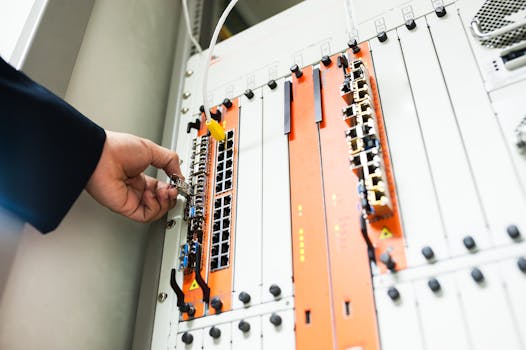
From Copper to Fiber: The Revolution of Internet Infrastructure in Africa
From Copper to Fiber: The Revolution of Internet Infrastructure in Africa is a significant transformation that is taking place in the continent. The internet infrastructure in Africa is undergoing a major upgrade from traditional copper cables to fiber optic cables, which is revolutionizing the way people connect and access information.
Introduction to Africa’s Internet Infrastructure
Africa’s internet infrastructure has come a long way since the introduction of the internet in the continent. Initially, the internet was only available in a few countries, and the connection was slow and expensive. However, with the advent of fiber optic cables, the internet has become faster, cheaper, and more widely available.
The traditional copper cables that were used to connect homes and businesses to the internet were prone to outages, slow speeds, and high maintenance costs. However, with the introduction of fiber optic cables, these problems are becoming a thing of the past. Fiber optic cables use light to transmit data, which makes them faster, more reliable, and less prone to outages.
The Benefits of Fiber Optic Cables
The benefits of fiber optic cables are numerous. They offer faster internet speeds, which is essential for businesses and individuals who rely on the internet for their daily activities. Fiber optic cables also provide a more reliable connection, which is critical for applications such as online banking, e-commerce, and video conferencing.
In addition to faster speeds and reliability, fiber optic cables are also more secure than traditional copper cables. They are less prone to hacking and cyber attacks, which is a major concern for businesses and individuals who use the internet for sensitive activities.
Challenges Facing the Adoption of Fiber Optic Cables in Africa
Despite the benefits of fiber optic cables, there are several challenges facing their adoption in Africa. One of the major challenges is the high cost of installing fiber optic cables. The cost of laying fiber optic cables is high, especially in rural areas where the population is sparse and the terrain is difficult.
Another challenge facing the adoption of fiber optic cables in Africa is the lack of infrastructure. In many African countries, the infrastructure to support fiber optic cables is lacking, which makes it difficult to install and maintain the cables.
Conclusion
In conclusion, the transformation of Africa’s internet infrastructure from copper to fiber optic cables is a significant development that is revolutionizing the way people connect and access information. While there are challenges facing the adoption of fiber optic cables, the benefits they offer make them an essential component of Africa’s internet infrastructure.
The adoption of fiber optic cables in Africa is a complex process that requires careful planning, investment, and coordination. However, with the right strategies and investments, Africa can reap the benefits of fiber optic cables and become a hub for digital innovation and economic growth.
Future of Internet Infrastructure in Africa
The future of internet infrastructure in Africa looks bright, with many countries investing heavily in fiber optic cables and other digital infrastructure. The African Union’s Digital Transformation Strategy for Africa, which was launched in 2020, aims to accelerate the adoption of digital technologies and promote economic growth and development.
The strategy outlines several key areas of focus, including the development of digital infrastructure, the promotion of digital literacy, and the creation of a conducive business environment for digital innovation. With the implementation of this strategy, Africa is poised to become a major player in the global digital economy.
In addition to the African Union’s Digital Transformation Strategy, there are several other initiatives that are promoting the adoption of fiber optic cables and other digital infrastructure in Africa. These initiatives include the African Development Bank’s Digital Africa initiative, which aims to promote digital innovation and entrepreneurship in Africa.
The future of internet infrastructure in Africa is also being shaped by the growing demand for digital services, including e-commerce, online education, and digital healthcare. As more Africans come online, there will be a growing need for fast, reliable, and secure internet connections, which will drive the adoption of fiber optic cables and other digital infrastructure.
Impact of Fiber Optic Cables on African Economies
The impact of fiber optic cables on African economies cannot be overstated. The adoption of fiber optic cables is expected to have a significant impact on economic growth, job creation, and poverty reduction. According to a report by the World Bank, the adoption of fiber optic cables can increase economic growth by up to 1.4% per year.
The report also notes that the adoption of fiber optic cables can create up to 1 million new jobs in Africa, mainly in the ICT sector. Additionally, the report notes that the adoption of fiber optic cables can reduce poverty by up to 0.7% per year, as more people gain access to digital services and economic opportunities.
In conclusion, the transformation of Africa’s internet infrastructure from copper to fiber optic cables is a significant development that is revolutionizing the way people connect and access information. The benefits of fiber optic cables, including faster speeds, reliability, and security, make them an essential component of Africa’s internet infrastructure.
The adoption of fiber optic cables in Africa is a complex process that requires careful planning, investment, and coordination. However, with the right strategies and investments, Africa can reap the benefits of fiber optic cables and become a hub for digital innovation and economic growth. The future of internet infrastructure in Africa looks bright, with many countries investing heavily in fiber optic cables and other digital infrastructure.



